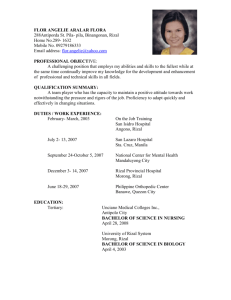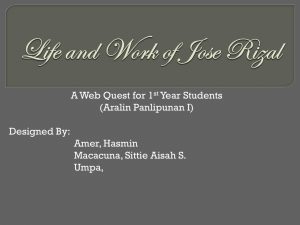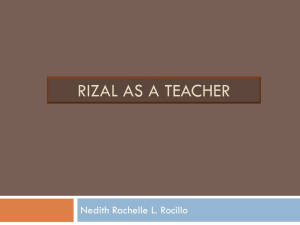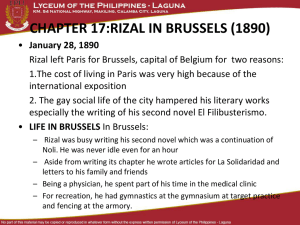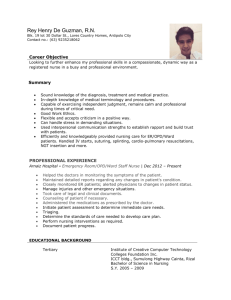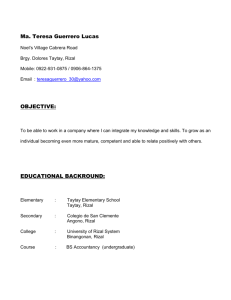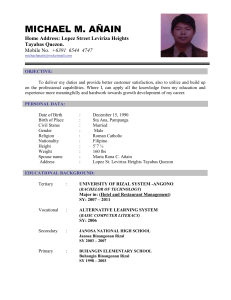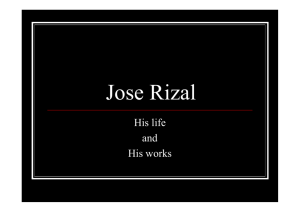A walking tour of places associated with Dr. José Rizal
advertisement
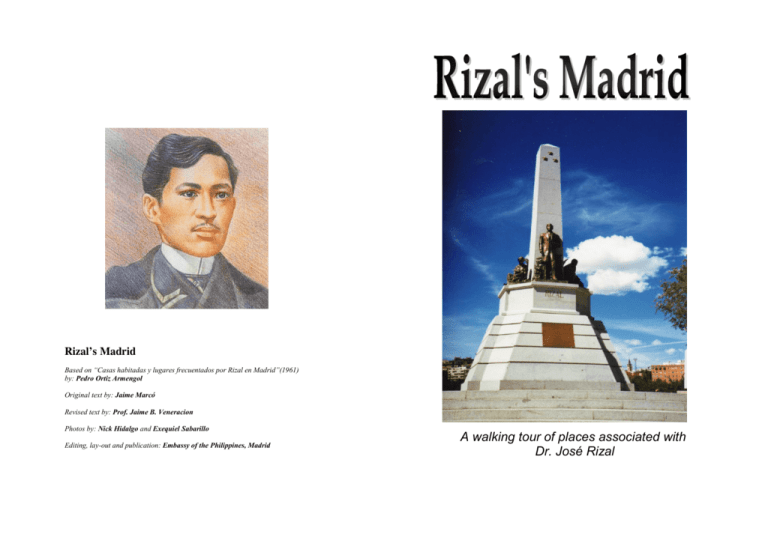
Rizal’s Madrid Based on “Casas habitadas y lugares frecuentados por Rizal en Madrid”(1961) by: Pedro Ortiz Armengol Original text by: Jaime Marcó Revised text by: Prof. Jaime B. Veneracion Photos by: Nick Hidalgo and Exequiel Sabarillo Editing, lay-out and publication: Embassy of the Philippines, Madrid A walking tour of places associated with Dr. José Rizal INTRODUCTION Did you know that there is a Rizal in each one of us? Or to put it another way, that there is an element of us in Rizal. A cliché perhaps or a trite expression, yet how could it be otherwise? As a Filipino, Rizal shared the anguish and anxiety of a foreigner in another land. Like the thousands of Filipinos here in Spain, Rizal came from a tropical country, with so much hope for himself, for his family and his country. Rizal could not have been different from you and I as, upon arrival, he looked for an immediate relative or friend to take care of him. He was given to comparing this or that place with his own Calamba and Laguna de Bay expressing thereby the common sentiment of exiles longing for the sites of childhood. Far from loved ones, solitude led Rizal to flirt with women as some of our migrants in Spain are wont to do. Likewise, he would be like anyone of us trying to understand the peculiar Spanish way of doing things – why for instance, the Spaniards have late breakfasts, late lunches and late dinners. To fathom the Spanish character would have required going through a process of discovering the places where they eat, how they live and what they have for entertainment. THE EMBASSY OF THE PHILIPPINES Calle Eresma 2, 28002 MADRID Phone (0034) 91-782.38.30 Fax (0034) 91-411.66.06 Could Rizal be different from us in going to the rastro to buy cheap but still usable suits or shoes or trying the entertainment at the cava and maison at the Plaza Mayor, the excitement of an afternoon at the Plaza de Toros and the childlike pleasure of whiling away his time at the zoo? Would anyone be surprised that Rizal like most Filipinos participated in the game of chance called lotería? It is hard to imagine that any place in Madrid could not have been traversed by Rizal. For like us, Rizal was curious to know the places in Madrid that Madrileños themselves found interesting and likewise, important to satisfy one’s basic needs. Yet, it is also true that Rizal’s Madrid could have been different from ours. He was first of all an intelligent man, a scholar and a student, a man of varied interests that went beyond those possessed by many of us. Even during his time, his contemporaries thought Rizal to be very moralistic, for he was not given to spending idle moments – preferring the library to bars, or a discussion of issues to useless talk or chismes. When we therefore say that this or that place was “Rizal’s Madrid,” we have in mind the Rizal that to us represented the best in us. He had a higher purpose in life, and found meaning in becoming a model for his The basic goal of the Philippine Embassy in Madrid is to advance the interests of the Philippines and the Filipinos in the Kingdom of Spain, as well as, in the Principality of Andorra. Its priorities are to protect the rights and well-being of Filipino citizens and to gain new trade, investment and tourism markets for the country, thereby contributing to the task of Philippine economic development. THE RIZAL MONUMENT (AVENIDA DE LAS ISLAS FILIPINAS CORNER C/ SANTANDER) The last place our tour brings us to is at the junction of Avenida de las Islas Filipinas and C/ Santander where the Rizal monument stands. Built in 1996, it is a replica of the Rizal monument at the Luneta in Manila. The original monument was designed by a Swiss sculptor, Richard Kissling, and was one of the major winners in a contest during the American regime in the Philippines. During the Rizal birth centennial in 1961, some countries honored Rizal with markers and monuments. Heidelberg, Germany where Rizal spent some time in the 1880s, erected a modest but elegant statue in his honor, for making that city famous through his poem entitled “To the Flowers of Heidelberg.” Mexico City built a replica of the Rizal monument at the Luneta in their famous boulevard called Paseo de la Reforma. At that time, Spain refused to honor the Philippine hero because of the sentiment then that he was a traitor to the mother country, Spain. But times have changed. In a new spirit of broadened friendship between Spain and the Philippines, as well as a liberal view of why the latter launched a revolution, Rizal’s position has been elevated. He is not only a Filipino patriot; he is an exemplar of the best in the human race. And Spain itself is honored by Rizal’s presence here, for it is in this country that he developed his sensitivities and his scientific, artistic and literary skills -- in Madrid, the heartland of the Empire. countrymen and a true lover of his country. The places we have identified and described as “Rizal’s Madrid” would show not so much those he simply visited as those which were the sites of his personal struggles for the recognition of his country as a civilized nation, a place of one’s birth which, to use Ninoy Aquino’s words, “is worth dying for.” WHERE RIZAL HAD LIVED C/ AMOR DE DIOS 13-15 Our walking tour shall begin with the place of his residence from September 12, 1882 to May 1883, when he first arrived in Madrid. Rizal was prepared to lead a spartan life since he had a limited allowance of 50 pesos a month further reduced to 35 pesos when the Rizal farm was affected by bad harvests. There was also a constant increase in rent being imposed by the Dominicans from whom the Rizal family rented the farm. In this Madrid house, Rizal lived with Vicente Gonzalez, an old friend from his Ateneo de Manila days and a guy whom he fondly called Marques de Pagong. The house could have been chosen out of convenience since it was near the university and the atelier in which Rizal’s interest in the arts developed into fine form. He could therefore save on transportation costs. There was a piano and four big mirrors that created lasting impressions on Rizal. C/ FERNANDEZ Y GONZALEZ 8, PLANTA 3º, PUERTA NUM. 4 (FORMERLY C/ DE LA VISITACIÓN 8) This was his place of residence from May 1883 to June 17, 1883 before Rizal left for Paris for a vacation. Situated in the old part of Madrid close to the Plaza Sta. Ana and right behind the Teatro Español, it stood near the corner of c/ Echegaray (formerly c/ del Lobo), where he criticized his fellow residents for engaging in idle discussions day after day. He lived here with Eduardo de Lete and Ceferino de Leon. By their agreement, they did not allow gambling (juego de azar) in their quarters. HOTEL INGLÉS, C/ ECHEGARAY Aside from Restaurante Madrid, Hotel Inglés figured prominently as a place where the Filipino community in Madrid marked or celebrated its most important events. In 1884, this was the venue for the banquet in honor of Luna and Hidalgo. The place retains its 19th century ambience and has at the lobby a marker indicating the year of its construction, the representative menu then, and the events celebrated there such as zarzuelas, musical presentations and plays. On its walls are paintings showing the hotel’s original look. C/ VENTURA DE LA VEGA (FORMERLY C/ BAÑO 15, PISO PRINCIPAL OR 1º) This was the residence of D. Pablo Ortiga y Rey, vice president of the Consejo de Filipinas and the headquarters of Circulo Hispano Filipino. In a letter to this family dated October 10, 1882, Rizal mentioned having boarded here from 1883 (autumn) to August 1884, apparently on a temporary basis since the following entries would indicate that he had other places of residence in Madrid. The association (CHF) was organized as a forum for Filipino students to discuss Philippine affairs. It sponsored regular bailes to raise funds for the association. It published a magazine financed by Juan Atayde, a Philippine-born Spaniard. Among those with whom Rizal discussed Philippine issues were the Paternos -- Pedro, Maximino and Antonio -- and Gregorio Sangciangco y Goson who made deep impressions on Rizal. The latter wrote El Progreso de Filipinas which said that a plan for agriculture, commerce and industry could usher in improvements and progress in the Philippines. The association did not last long, as Rizal wrote to his family on January 29, 1883, that it disbanded upon his suggestion apparently due to lack of sufficient interests of the members. The residence had another attraction for Rizal aside from being the venue of political discussions. The daughter of the owner, Consuelo Ortiga y Rey caught Rizal’s fancy. However, Consuelo was torn between Rizal and de Lete. Rizal even gave Consuelo poems, musical pieces from Paris and guimaras, a kind of textile from the Philippines. The guimaras gift was acknowledged by Consuelo through de Lete, which seemed to have put an end to Rizal’s illusions about her love, his first derrota or defeat as he wrote in codes in his diary. Aside from the Luna-Hidalgo banquet, the Filipino community would sometimes hold their cenas in the hotel in celebration of the New Year. Even today, Hotel Ingles is used by the Filipino community as, for example, when it celebrated the centennial of the Revolution and the First Republic with President Fidel V. Ramos in attendance. CONGRESO DE ESPAÑOLAS) LOS DIPUTADOS (FORMERLY LAS CORTES The Filipino community lobbied in this building for the recognition of the Filipinos’ right to autonomy and for equal rights with Spanish citizens. This is not far from the areas where the Filipino community lived and is just across the park dedicated to the memory of Cervantes, the famous creator of Don Quixote de la Mancha and Sancho Panza. “Balandristas,” playing guitar and other musical instruments. At the opposite end was a mural with a country scene, showing girls at a picnic in the meadow, a setting associated with the period of the Spanish painter Goya. It was during the times the Filipino students met in this bar that they formed their stand on various issues affecting the Philippines. Today, the place is a venue for flamenco dance presentations and musical bands playing popular and classical Spanish songs. Its 19th century ambience is looked upon with pride by its owners and personnel. There is a variety of wine served at the usual Spanish time of fun and enjoyment, that is, towards dusk until the break of dawn. VIVA MADRID, C/ MANUEL FERNANDEZ Y GONZALEZ, 7 Another hangout famous for its beautiful murals of azulejos or glazed tiles where Rizal used to take his light meals with wine, this was likewise the favorite place of Graciano Lopez Jaena who had the reputation of being “a man of the world and of wine.” A marker proudly exhibited in the establishment mentions its association with the Filipino community in Madrid at that time. The place would tell us that it was not “all work and no play” for our national hero. We can imagine him and his friends spending hours in some afternoons sipping wine while admiring the beautiful women passing by. Rizal would even say that he had spent two pesetas and 90 centimos for a baile at the El Excelsior, perhaps a nearby cabaret for the public as was the style of the time. C/ GRAN VIA 22 (FORMERLY C/ SAN MIGUEL 7, 1º) Rizal stayed in this place, a pension, as indicated in a letter to his parents dated September 11, 1883. Starting September 6 of that year, he was paying a daily rent of four pesetas a day. He said that this amount excluded the cost of kerosene which he had to buy himself so he could read and study at night. But perhaps the conditions were not that ideal for him as later, he had to board in another place with a Filipino student. C/ DEL BARQUILLO 34, 4º The Gran Vía residence was indeed only temporary since in the same letter to his parents, he asked that all future letters be forwarded to this address. He joined Esteban Villanueva who came to Madrid to study law but later became an established painter. It seems that painting and the arts as disciplines, had such an attraction to Filipinos since a number of them pursued these as careers – Luna, Hidalgo, Melecio Figueroa, an engraver and Villanueva. Rizal at that point was in dire financial difficulties. In his report on his whereabouts, he mentioned his high grades in medicine, his victory in Greek contests and exams in Historia Universal but said he had to pawn Saturnina’s ring given to him, to pay for his exams. At one time, Rizal did not have any meal at all for one whole day. Fortuitously, he had been asked by the Paternos to deliver one of the main speeches at a banquet, a toast to Juan Luna and Felix Resurreccion Hidalgo who had just won first and second prizes (for the Spoliarium and Virgenes Cristianas Expuesta al Populacho), respectively, at the art competition sponsored by the Exposicion de Bellas Artes in Madrid. He wrote these in codes in his diary which were later decoded by Miguel Unamuno, his Spanish friend, upon the request of Wenceslao Retana. C/ PIZARRO 15 (FORMERLY, PIZARRO 13, 2º - DCHA.) In a letter to his family, on August 29, 1884, Rizal informed them of living here with classmates Ceferino de Leon and Julio Llorente. It was very close to the Facultad de Filosofia y Letras at c/ Bernardo where he was to finish in a year his philosophy and letters degree. It was here where he wrote to his family why sugar prices had fallen – Cuba and Puerto Rico, as well as the colonies of Great Britain, had replaced the Philippines as the new sources of U.S. imports, the biggest at that time. It was also here where Rizal quietly started his novel Noli Me Tangere. C/ CEDACEROS 11, PISO PRINCIPAL This was perhaps his last residence in Madrid as he himself mentioned in an undated letter to his family. He spent 15 days here – from October 1 to 15, 1885 – sharing the place with Ceferino de Leon and Eduardo de Lete. He told his parents that he would be moving to Paris and Berlin to study ophthalmology under the best professors at that time. The eyesight of Teodora Alonso had gone worse and it was Rizal’s desire to treat her upon his return to the Philippines. On the matter of his return to the Philippines, his brother Paciano advised him to stay in Hong Kong instead since this would not be very far from home. The reputation of Rizal as an anti-friar intellectual had become public because of his speech at the Hotel Ingles at the banquet to honor Juan Luna and Felix Resurreccion Hidalgo. According to Paciano, returning to the Philippines would be fatal since a lot of Spaniards were raring to punish him for claiming that the Indios could be even better than the colonial masters if given the chance to develop themselves. specimens. For including in the exhibition “samples of Philippine peoples” such as the Igorots, Manobos and Negritos, Rizal criticized “civilized” Spain for violation of their human rights. It seemed to Rizal that the exhibition was no better than a zoo where Madrileños laughed in disdain as they looked at these “primitive” examples of the human race. Rizal was particularly bitter when in the winter, a member of the group, an Igorot woman, died and others contracted pneumonia due to the cold. C/ ATOCHA, 43 La Solidaridad used this place as its office of publication. Founded in 1889, the newspaper was the voice of the Filipino community in Spain in its struggle for recognition by the Spanish government, of their desire for autonomy. Before his decision to return to a place near the Philippines (Hong Kong), Rizal might have frequented this place to check on the progress of the publication of his essays, the most famous of which was his La Indolencia de los Filipinos. The essay was in response to the then popular Spanish notion that the lack of progress in the Philippines was due to the laziness of the colonial subjects. Rizal asserted that there were factors beyond human control, such as the Philippines’ hot, humid and tropical weather, that would explain the supposed laziness of the Filipinos. And in any case, Rizal said, the Filipinos were no worse than the Spaniards who were lazy relative to the Germans and the Dutch of northern Europe. Having debunked the Spanish assertions, Rizal then proposed measures that would make the Philippines progressive, adopting in particular the suggestions of his fellow student, Gregorio Sanciangco y Goson – build railroads, adopt modern agricultural technology and solve the problem of land ownership for the Philippines to attain progress. WHERE RIZAL HAD STUDIED LOS GABRIELES ( C/ ECHEGARAY 17) FACULTAD DE MEDICINA, UNIVERSIDAD DE MADRID, C/ ATOCHA The corridor of the Colegio de Medicina (Hospital de San Carlos) has a marker indicating that it was here where Rizal studied medicine. He began his medical studies on October 2, 1882, and finished it two years later in June 1884. One of his professors was the then famous Marquez de Busto. The other professors he had mentioned were Drs. Mariani, Polo and Stocker. He apparently spent his This was a rendezvous for the Filipino propagandists in whose halls were displayed two murals made of ceramic tiles described by Rizal in a letter to his sisters. It had a group of skeletons forming a band, the ATENEO DE MADRID, C/ PRADO, 21 Although not an educational institution but an exclusive club for men of letters and science, the Ateneo contributed to the professional development of Rizal. It was here where he regularly attended theatrical presentations, music and poetry recitals and book launchings. He was in attendance when Ramon de Compoamor delivered his best poetry in 1884. It was also at the Ateneo where he studied English under the tutelage of Sr. Schüts. At one time, Rizal was presented to the Principe de Baviera, then presiding over the meeting. Even now, the ambience of the Ateneo is one of quiet, civility and seriousness, with people spending their time in high-ceilinged rooms and galleries. The theatre has retained the classical stage reminiscent of a place for Greek plays. On the hallway are portraits of its most prominent members. Rizal’s portrait used to hang at the end of the hallway. RIZAL’S NATIONALIST CONSCIOUSNESS PARQUE DEL BUEN RETIRO This was Rizal’s favorite park in Madrid which inspired him to name his place of exile in Dapitan, Zamboanga del Norte as “Mi Retiro.” This was also the site of the Exposición de Filipinas of 1887 in whose Palacio Cristal pavilions were exhibited Philippine artifacts, art works and botanical residency at the Hospital de la Princesa where, as he had written to his family, he performed two operations on detached ligatures. But as time went on, Rizal’s heart was not in medicine as shown by his enrolment in other courses. His medical interest was animated more by a desire to remove cataracts on his mother’s eyes; she was then close to being blind. Already losing her eyesight, Rizal’s mother could write to him only with the assistance of one of her daughters. Rizal would have to go to Paris to specialize in ophthalmology. ESCUELA DE BELLAS ARTES DE SAN FERNANDO, C/ ALCALÁ At the same time that Rizal was taking courses in medicine, he went to the nearby Escuela de Bellas Artes de San Fernando and took five hours of painting lessons under Carlos de Haes. He likewise enrolled at the Facultad de Derechos, (UCM) but his brother dissuaded him from continuing the course. Rizal’s interest in law was in line with the desire for political autonomy in the Philippines. But his interest in the humanities overtook all other interests. He transferred to the Facultad de Filosofia y Letras, and worked towards a humanities course which he finished in June 1885. This faculty was then located at c/ Bernardo, the building housing it then is now occupied by the Ministerio del Justicia. ITINERARY OF “RIZAL’S MADRID” WALKING TOUR 1. Las Cortes Españolas (Starting Point) – place where Rizal and his friends lobbied for Philippine rights 2. Ateneo de Madrid, C/Prado, 21 – where Rizal studied English, did research work and watched theater plays 3. C/ Amor de Dios, 13-15 – Rizal’s first place of residence, September 1882 4. Facultad de Medicina de San Carlos – where Rizal finished his course in Medicine, June 28, 1884 5. C/ Atocha, 43 – place where “La Solidaridad” was published 6. Viva Madrid (Restaurant), C/ Manuel Fernández y Gonzalez 7 – Rizal’s hangout and the place where he took most of his meals 7. Los Gabrieles (Bar), C/ Echegaray, 17 – frequented by the Philippine Propaganda Movement in 1882 8. C/ Manuel Fernández Gonzáles, 8 (formerly C/ Visitación) – Rizal’s second residence, May – June 1883 9. Hotel Inglés, C/ Echegaray – venue of banquet in honor of Luna and Hidalgo where Rizal gave a speech urging the Filipino youth to follow in the footsteps of Luna and Hidalgo 10. Ventura de la Vega, 15 (formerly C/ Baño) – housed the Circulo Hispano, an association of Filipino students and Spanish sympathizers 11. Real Academia de Bellas Artes de San Fernando – where Luna, Hidalgo and Rizal studied Fine Arts
